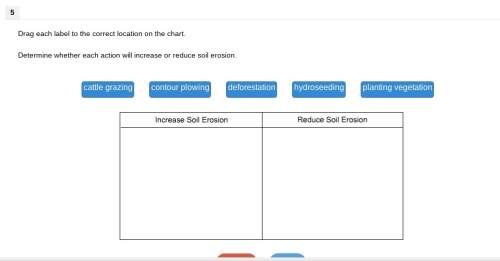
Biology, 07.04.2021 01:00 ashiteru123
Please keep in mind I would prefer it if someone actually answered the over view of the lab. I already completed ALL the other questions soo, Please help?
1. What is the purpose of the lab?
The main purpose of lab is to perform different experiments and importance of the topic that it supports.
2. What procedure did you use to complete the lab?
Outline the steps of the procedure in full sentences.
I made a hypothesis, observed my experiments, used a procedure, had and prepared materials that are needed, evidence that support my thesis, and made a conclusion.
Section II: Observations and Conclusions
3. What charts, tables, or drawings would clearly show what you have learned in this lab?
Each chart, table, or drawing should have the following items:
a. An appropriate title
b. Appropriate labels
Bases Acids
Freshwater Increases pH making it a harsher environment that animals can’t live in. Decreases pH having a similar effect of environmental change as bases.
Groundwater Doesn’t have much effect until water from the lake, pond, other freshwater sources leaks into the groundwater affecting our water supply. Acids have the same effect on the water, although I did notice (for both acids and bases) that the slow buildup temporarily stopped the flow of the freshwater to the groundwater and the opposite way around.
4. If you could repeat the lab and make it better, what would you do differently and why?
There are always ways that labs can be improved. Now that you are a veteran of this lab and have experience with the procedure, offer some advice to the next scientist about what you suggest and why. Your answer should be at least two to three sentences in length.
I would attempt to visit multiple sites instead of one. Visiting one body of water you would only get to use water from that site. For future reference, see if it’s possible to go to multiple different water sources. If this does happen to be possible, you would be able to experiment with your water more and using water from different locations. I find this exciting because you would also be able to see how the water differs in colors and/or pH.
Writing the Lab Report
Now you will use your answers from the four questions above to write your lab report. Follow the directions below.
Section I: Overview of Lab
Use your answers from questions 1 and 2 (above) as the basis for the first section of your lab report. This section provides your reader with background information about why you conducted this lab and how it was completed. It should be one to two paragraphs in length.
Section II: Observations and Conclusions
Use your answers from questions 3 and 4 (above) as the basis for the second section of your lab report. This section provides your reader with charts, tables, or drawings from the lab. You also need to incorporate your answers to the follow-up questions (from the Student Guide) in your conclusions.
Overall
When complete, the lab report should be read as a coherent whole. Make sure you connect different pieces with relevant transitions. Review for proper grammar, spelling, punctuation, formatting, and other conventions of organization and good writing.
Thanks if you did help!

Answers: 1


Another question on Biology

Biology, 22.06.2019 01:40
Elephants in the savanna regions of africa dig holes in dried up river beds to reach water lying just below the surface. these holes provide drinking water for other animals as well. so, without the elephants, many animals might otherwise die from lack of water during the dry season. the location in which the elephants live is an example of a/n and the role they play in creating water holes is an example of a a) ecosystem; habitat b) community; niche c) habitat; niche d) niche; habitat
Answers: 1

Biology, 22.06.2019 05:30
How is transcription similar to translation in terms of base pairing?
Answers: 3


Biology, 22.06.2019 16:30
Drag the tiles to the correct boxes to complete the pairs. match wach fossil with the layer where it’ll be present based on these condition
Answers: 3
You know the right answer?
Please keep in mind I would prefer it if someone actually answered the over view of the lab. I alrea...
Questions


Business, 17.08.2020 01:01

Biology, 17.08.2020 01:01


Mathematics, 17.08.2020 01:01







Mathematics, 17.08.2020 01:01



Mathematics, 17.08.2020 01:01


Mathematics, 17.08.2020 01:01

Mathematics, 17.08.2020 01:01

Advanced Placement (AP), 17.08.2020 01:01





